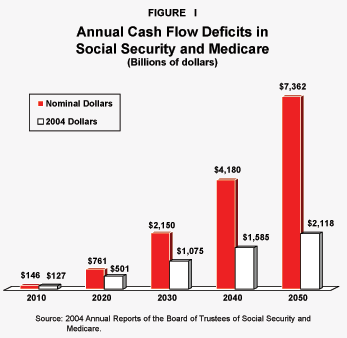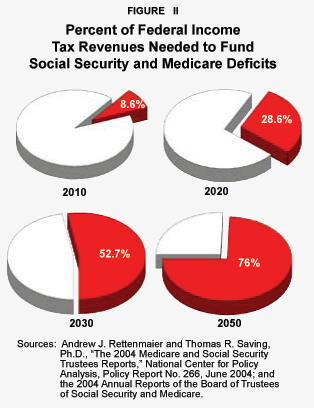In 2011, the first group of baby boomers will reach the age of 65. When the last of that generation retires in 2032, 77 million of them will have ceased working and paying taxes and will have begun receiving taxpayer-funded health care and pension benefits. A similar trend is occurring throughout the developed world. In Japan, Europe and North America, the number of retirees will double over the next 25 years while the number of taxpayers will grow only 10 percent. The economic consequences of these changes are dire: higher taxes, slower growth and lower living standards.
Cash Flow Deficits. In a pay-as-you-go system, what matters most is cash flow. And the cash flow drain that elderly entitlement programs portend is not a problem of the distant future, as some argue. The problem has already begun.
Social Security and Medicare have been receiving more in payroll taxes than they have been paying out in benefits for several decades. The declining U.S. population growth rate, however, is already taking its toll. Last year, the two programs combined spent more than they took in, requiring a general revenue subsidy of about $45 billion. The magnitude of the deficits in these two programs will soar in the years to come.
For those who believe that Social Security and Medicare are in sound financial shape for decades to come, Figure I  presents a sobering picture. In 2010, the federal government will need $127 billion in additional funds to pay promised benefits. Five years later, the size of the annual deficit will double. Five years beyond that, it will double again. In just 15 years, the federal government will have to raise taxes, reduce other spending or borrow $761 billion to keep its promises to America's senior citizens.
presents a sobering picture. In 2010, the federal government will need $127 billion in additional funds to pay promised benefits. Five years later, the size of the annual deficit will double. Five years beyond that, it will double again. In just 15 years, the federal government will have to raise taxes, reduce other spending or borrow $761 billion to keep its promises to America's senior citizens.
As the years pass, the size of the deficits will continue to grow. Without changes in worker payroll tax rates or senior citizen benefits, the shortfall in Social Security and Medicare revenues compared to promised benefits will top more than $2 trillion in 2030, $4 trillion in 2040 and $7 trillion in 2050.
These deficit numbers include projected inflation. Yet even in 2004 dollars, the numbers are still staggering. Valued in today's dollars, the annual Social Security deficit will top $50 billion in 2020, $250 billion in 2030 and $400 billion in 2050. Adding Medicare's deficits, the federal government will need more than $500 billion in 2020, $1 trillion in 2030 and $2 trillion in 2050 to fund elderly entitlement programs alone.
Note that these estimates, which come from the latest Social Security Trustees report, do not include the growing burden of senior health care costs under Medicaid.
Deficits as a Percentage of Other Federal Revenues. The combined budget shortfalls for Social Security and Medicare are so large that it is difficult to comprehend what the numbers mean. Figure II  presents the projected deficits as a percentage of federal income tax revenues. It shows that combined Social Security and Medicare deficits will equal more than 28 percent of federal income taxes by 2020. Roughly this means that in just 15 years, if the federal government is to keep its promises to seniors, it will have to stop doing more than one-fourth of every thing it does today. Alternatively, we will have to raise income taxes by one-fourth or borrow an equivalent sum of money.
presents the projected deficits as a percentage of federal income tax revenues. It shows that combined Social Security and Medicare deficits will equal more than 28 percent of federal income taxes by 2020. Roughly this means that in just 15 years, if the federal government is to keep its promises to seniors, it will have to stop doing more than one-fourth of every thing it does today. Alternatively, we will have to raise income taxes by one-fourth or borrow an equivalent sum of money.
By 2030, about the midpoint of the baby boomer retirement years, federal guarantees to Social Security and Medicare will require one in every two income tax dollars. By 2050, they will require three in every four.
What about the Trust Funds? The Social Security and Medicare Trust Funds serve an accounting function, not an economic one. They work like this: When payroll tax revenues exceed expenses, the U.S. Treasury issues special bonds to keep track of the surplus. Unlike other Treasury securities, however, these bonds are not sold in the marketplace. They are created on paper and placed in filing cabinets in Parkersburg, West Virginia, while the actual surplus payroll tax dollars are spent on other things. When tax revenues fall short of expenses, the process is reversed: the bonds are taken out of the filing cabinets and retired.
The Social Security Trust Fund currently holds about $1.6 trillion of these non-negotiable bonds. But these bonds cannot pay benefits. Although they are treated as assets of the trust fund, they are also liabilities of the Treasury. Summing over both agencies of government, assets plus liabilities net out to zero. If the federal government had purchased assets with the Social Security surpluses, the trust funds would today represent real economic value. Instead, the funds were spent in other ways and the government essentially wrote IOUs to itself.
If a fire were to destroy the filing cabinets in Parkersburg, this would in no way diminish the capacity of the federal government to pay benefits. Alternatively, if a stroke of the President's pen were to double or triple the number of bonds in those filing cabinets, that would in no way increase our ability to pay benefits. If we could create value by writing IOUs to ourselves, Social Security would have no financial problems. Unfortunately, there is no free lunch.
Social Security vs. Medicare. Over the long term, the unfunded liability under Medicare is six times the unfunded liability under Social Security. However, Social Security and Medicare are inextricably linked. Both are pay-as-you-go programs. Both will be drastically affected by the aging of the population.
One way to think about the current financial picture is to see that Social Security surpluses are covering Medicare's deficits. After 2018, both programs will be running deficits. Any change that helps one program will automatically help the other.
Conclusion. The federal deficit this year is projected to be the largest in U.S. history, and President Bush has pledged to cut it by half. Even if he is successful, the United States will still face equally large (and rising) deficits due to our elderly entitlement programs.
John C. Goodman is president of the National Center for Policy Analysis.